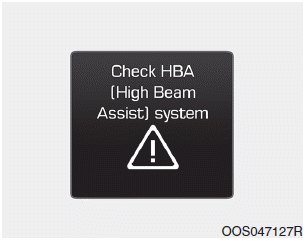Hyundai i-30: If you have a flat tyre (with tyre mobility kit) / Checking the tyre inflation pressure


1. After driving approximately 7~10 km (4~6 miles or about 10 min), stop at a safety location.
2. Connect the filling hose (3) of the compressor directly to the tyre valve.
3. Plug the compressor power cord into the vehicle power outlet.
4. Adjust the tyre inflation pressure to the recomended tyre inflation. With the ignition swithched on, proceed as follows.
- To increase the inflation pressure
: Switch on the compressor.
To check the current inflation
pressure setting, briefly switch
off the compressor.
- To reduce the inflation pressure:
Press the button (9) on the
compressor.
NOTICE
Do not let the compressor run for more than 10 minutes, otherwise the device will overheat and may be damaged.
Information
The pressure gauge may show higher than actual reading when the compressor is running. To get an accurate tyre reading, the compressor needs to be turned off.
CAUTION
If the inflation pressure is not maintained, drive the vehicle a second time, refer to Distributing the sealant. Then repeat steps 1 to 4.
Use of the TMK may be ineffectual for tyre damage larger than approximately 4 mm (0.16 in).
We recommend that you contact a HYUNDAI authorised repairer if the tyre cannot be made roadworthy with the Tyre Mobility Kit.
WARNING
The tyre inflation pressure must be at least 220 kPa (32 psi). If it is not, do not continue driving.
Call for road side service or towing.
CAUTION
Tyre pressure sensor (if equipped with TPMS)
The sealant on the tyre pressure sensor and wheel should be removed when you replace the tyre with a new one and inspect the tyre pressure sensors at an authorized dealer.
Information
When reinstalling the repaired or replaced tyre and wheel on the vehicle, tighten the wheel lug nut to 11~13 kgf·m (79~94 lbf·ft).
 Using the Tyre Mobility Kit
Using the Tyre Mobility Kit
CAUTION
Detach the speed restriction
label (1) from the sealant bottle
(2), and place it in a highly visible
place inside the vehicle
such as on the steering wheel
to remind the driver not to drive
too fast...
 Towing
Towing
Towing service
If emergency towing is necessary,
we recommend having it done by a
HYUNDAI authorised repairer or a
commercial tow-truck service...
Other information:
Hyundai i30 (PD) 2018-2025 Service Manual: Repair procedures
Operating Condition for the ISG function 1. Auto stop or Auto start condition ▶ If all of the below conditions are satisfied • If the following conditions are not met, entry into the ISG system is prohibited...
Hyundai i30 (PD) 2018-2025 Service Manual: Alignment
Repair procedures Front wheel alignment • When using a commercially available computerized wheel alignment equipment to inspect the front wheel alignment, always position the vehicle on a level surface with the front wheels facing straight ahead...
Categories
- Manuals Home
- 3rd Generation i30 Owners Manual
- 3rd Generation i30 Service Manual
- Shift-lock system. Shift-lock release
- Light bulbs
- To activate the ISG system
- New on site
- Most important about car
Warning light and message

When the High Beam Assist (HBA)
System is not working properly, the
warning message will come on for a
few second. After the message disappears,
the master warning light ( )
will illuminate.
)
will illuminate.
